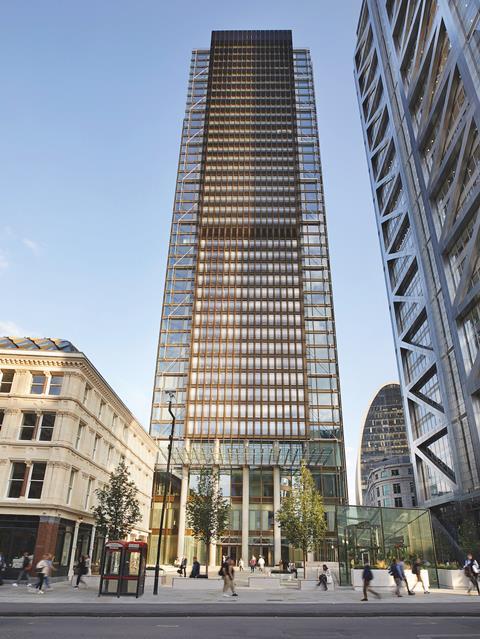The pair talk to Dave Rogers about the added risk of getting major schemes built at a time of rampant inflation and acute skills shortages ŌĆō and what they think the industry could do to attract more young talent. Photography by Tom Campbell

Laura Collins tells a story about an online careers event she attended this year where she was asked to promote construction as an industry to join. It was for a troop of 50 girl guides, aged between 10 and 17, and her 10-minute slot was sandwiched between a dance instructor and someone who worked in tech making software for video games.
A tough gig, then? ŌĆ£After IŌĆÖd finished, the first question I got was: do I get bullied by men?ŌĆØ
She admits she was shocked and a little deflated. ŌĆ£Why does this stereotype exist? We have the ability to do incredible things in this industry but itŌĆÖs not talked about enough in schools.
ŌĆ£ItŌĆÖs not given as an option; it has always been the last option. We need to get to the parents.ŌĆØ
Collins should know all about that, because that is exactly how she got into the industry. Raised in Essex, all the 18-year-old Collins wanted to do was work in London.
ŌĆ£I had no interest in construction at all ŌĆō I was going to work in insurance or something like that. I just wanted to get a City job; I didnŌĆÖt particularly want to go to university.
ŌĆ£My mum met a recruitment consultant on a plane coming back from Spain and they got chatting, and the consultant told my mum that I should come in for an interview with a firm.ŌĆØ
That company turned out to be Davis Langdon, where she became an apprentice QS, chartered at 23 before heading off to join MaceŌĆÖs consulting business and later Rider Levett Bucknall for a couple of years.
Now 34, Collins has been at Stanhope since 2019, where she is a project director and was recently in charge of the firmŌĆÖs Warwick Court scheme, a refurbishment of the old Goldman Sachs headquarters in Paternoster Square which sits in the shadow of St PaulŌĆÖs Cathedral.
Warwick Court, which was carried out by Mace, was procured entirely online because of the pandemic and the scheme had to ride out several storms ŌĆō both literal, with FebruaryŌĆÖs gales bringing work to a stop, and metaphorical such as the squeeze on labour caused by Brexit and then the coronavirus pandemic.
Built in the 1990s, Warwick Court is one of several refurbishment schemes that Stanhope will be carrying out in the coming years.
Over the summer, Multiplex was appointed to revamp the IBM building ŌĆō the listed landmark on LondonŌĆÖs South Bank completed in 1983 by architect Denys Lasdun ŌĆō while Stanhope will soon start work to overhaul Woolgate Exchange, a headquarters building near Guildhall in the City that was completed at the start of the 2000s.

Mace, which is tipped to carry out the Woolgate Exchange job, last year finished a ┬Ż50m overhaul of Garrard House, the former headquarters of banking giant Schroders which was built 24 years ago by Bovis on Gresham Street, near St PaulŌĆÖs.
The IBM building is a stoneŌĆÖs throw away from the ITV studios development, designed by Make and being developed by CO-RE, that was called in last month by Greg Clark in one of the last acts of his brief tenure as communities secretary.
CollinsŌĆÖ boss, Stanhope construction director Tony Wall, who celebrates 10 years at the business next autumn, says the ITV decision ŌĆō which has stalled plans to knock down the broadcasterŌĆÖs former headquarters and replace it with a mixed-use scheme ŌĆō has put firms like Stanhope on guard. ŌĆ£It makes you sit up and think: Why? What are the reasons? Is there a risk around the things we are doing?ŌĆØ
ItŌĆÖs more difficult to knock a building down and start again, so we have to think differently. If you can refurbish it, then why shouldnŌĆÖt you?
Laura Collins, project director, Stanhope
Wall adds: ŌĆ£WeŌĆÖre being asked questions today that wouldnŌĆÖt have been asked five years ago. WeŌĆÖre pushed a lot more around reuse. I think, as a business, we need to be pushing in that direction as well.ŌĆØ
Collins says: ŌĆ£ItŌĆÖs more difficult to knock it down and start again, so we have to think differently. If you can refurbish it, then why shouldnŌĆÖt you?ŌĆØ
Most of StanhopeŌĆÖs work is in London and its core output remains commercial work. But it is also getting involved in more life sciences jobs such as its schemes at Royal Street opposite St ThomasŌĆÖ Hospital and the British Library in the capital.
It is also working on Oxford North, a new science and technology hub just outside the city centre and ID Manchester, a city centre innovation district the firm is helping to develop alongside local firm Bruntwood.
Still, it has not forgotten its commercial heartland, with the firm involved in planned towers in the City of London at 55 Bishopsgate ŌĆō set to go in for planning before Christmas ŌĆō and 70 Gracechurch Street, which it bought in the spring for ┬Ż400m with joint venture partner Cadillac Fairview, a Canadian investor.
But Wall is worried about who will do the work should it all go ahead, notwithstanding the impact of a predicted recession. ŌĆ£If all the potential projects out there push the green button to go, there most certainly will be an issue around expertise. Everybody out there is trying to secure professional teams.
ŌĆ£All the tier 1s are fighting each other for talent. Over the last two years, thereŌĆÖs been a huge amount of movement between the top five or six contractors. There is a lot of work out there, which makes it a very different issue to previous recessions. If all that [work] happens, we will have problems with labour and professional shortages,ŌĆØ he says.
We are beginning to see some firms go under. There is a lot of pressure in terms of cash flow
Tony Wall, construction director, Stanhope
Wall believes the whole construction team ŌĆō including clients ŌĆō need to be more collaborative. ŌĆ£ItŌĆÖs all about trust. The more you talk and communicate, the better for everyone.

ŌĆ£There has to be an intelligent way of doing things rather than trying to throw risk at somebody that isnŌĆÖt capable of taking it. We are beginning to see some firms go under. They took a contract a couple of years ago, suffered huge inflation on that price and canŌĆÖt trade through it.ŌĆØ
He says some of the more labour-intensive trades are beginning to suffer. ŌĆ£There is a lot of pressure in terms of cash flow. We have a reduced pool of labour in London, post Brexit and covid. The whole market around inflation and pricing is up there as the number one issue.ŌĆØ
Wall worries that some clients are simply trying to hand risk down the supply chain. ŌĆ£You have this food chain. You canŌĆÖt just have people hanging out there on their own. YouŌĆÖve got to be responsible for whatŌĆÖs happening, and youŌĆÖve got to be a good client. I wish all clients would be.ŌĆØ
He adds: ŌĆ£If someone is struggling with a cash flow issue, IŌĆÖd much rather hear about it from them than go and find out about it somewhere down the line. If a bit of intervention can give somebody some help, and youŌĆÖre in a position where you can be [doing that], then you should be.
ŌĆ£People think they are passing on risk but, in some instances, just that very passing risk on is a risk because the person on the other side of the table taking that risk might not be able to accept it, and that happens far too much in our industry.ŌĆØ
Stanhope has quarterly meetings with its consultants ŌĆō its go-to QSs tend to be Alinea, Core Five and Exigere ŌĆō to take the temperature of the market and find out what is bothering them. It does the same with its contractors as well. The cost consultants tend to be all in the same room for their brainstorming. And the contractors? ŌĆ£WeŌĆÖre not that brave yet,ŌĆØ smiles Collins.
Laura Collins CV

2006 Joins Davis Langdon as apprentice QS in the firmŌĆÖs M&E business and becomes an M&E project surveyor. Schemes she worked on include ArgentŌĆÖs redevelopment of KingŌĆÖs Cross and the Heron Tower
2012-17 Associate director at Mace Consult, having joined as a project surveyor. Schemes she worked on include the HSBC headquarters in Birmingham
2017-19 Associate at Rider Levett Bucknall, where she worked on the Commonwealth Bank of Australia scheme in London
2019- Project executive and project director at Stanhope
Tony Wall CV

1995-2001 Various roles, including building manager at Mace
2001-11 Construction director, More London Development
2013- Construction director, Stanhope
Wall says that Stanhope has always had meetings like this but admits: ŌĆ£WeŌĆÖve turned up the volume since Brexit and covid. The [Ukraine] war has made us go further into the detail. Inflation is the number one issue. If you ask a contractor about inflation, you get a very different story to a cost consultant.ŌĆØ
He returns to the point about how many firms can do the work if it all comes to fruition. ŌĆ£WeŌĆÖve always enjoyed good relationships with the people weŌĆÖve used. But increasingly you are beginning to have to look around.ŌĆØ
Stanhope has hired Multiplex to carry out the IBM work, also known as 76 Upper Ground, under a ┬Ż120m deal. ŌĆ£They tendered three jobs before and came very close on two [both built by Lendlease]. Kier [another newcomer for Stanhope] is working with us at TV Centre [on a ┬Ż50m affordable housing scheme].ŌĆØ
Recruitment begins at school
Meanwhile, on the problem of the reduced pool of labour, the answer, for Collins, is simple: ŌĆ£It comes down to attracting people into the industry. We need parents to understand this is a profession. We do great stuff internally in the industry to say what weŌĆÖre doing to change it, but when you step outside the construction bubble, itŌĆÖs not talked about in schools.ŌĆØ
She says she recently took 30 girl guides to have a look at the Warwick Court scheme. A trip to McDonaldŌĆÖs, a treasure hunt in Paternoster Square and a spot of making something out of Lego were all on the agenda.
ŌĆ£We had the best day,ŌĆØ she remembers. ŌĆ£On the way home, they said they wanted to be a project manager or a structural engineer. ItŌĆÖs the parents we have to target. They told me they thought construction was about being an architect or a builder. They didnŌĆÖt realise all these other things existed.ŌĆØ
She thinks new recruits need to learn in an office as well, because working from home and having virtual catch-ups is not ideal for those starting out in their careers. ŌĆ£I started as an apprentice in 2006, and I got all my experience by listening to my colleagues. If youŌĆÖre not getting that, itŌĆÖs a bit difficult.ŌĆØ
When Collins joined Stanhope, she was the first woman in the operations team. ŌĆ£Now there are four or fiveŌĆØ out of a team of about 20, she says. ŌĆ£Sometimes people get a bit worked up and feel that all the women are coming for their jobs.
ŌĆ£I get pretty annoyed when people say ŌĆśyouŌĆÖve only got that because youŌĆÖre a womanŌĆÖ. Actually, itŌĆÖs because I work bloody hard and IŌĆÖm good at my job.ŌĆØ Still, maybe thatŌĆÖs why she got asked that question by those girl guides.
To underline the task that the industry faces, a recent survey of 1,100 people working in it found a quarter believed that better advice on construction for youngsters at school or college would help to tackle the skills problem. Other issues which put young people off, said respondents to the poll conducted to coincide with this monthŌĆÖs UK Construction Week, were that it was still seen as being too dirty and male dominated.
Collins, no doubt, would agree. ŌĆ£WeŌĆÖve got a labour issue, regardless of any diversity stat,ŌĆØ she says. ŌĆ£I shouldnŌĆÖt be relying on my mum meeting someone on a plane for me to get into this industry.ŌĆØ
In development
Stanhope has 2.3 million ft┬▓ of development under construction, including the 8 Bishopsgate office scheme that is due to be completed by Lendlease next spring, a residential scheme being carried out by Kier at Television Centre, and the Gateway West office scheme at White City Place being carried out by Sir Robert McAlpine. The sister Gateway Central scheme is also being carried out by McAlpine and has been part let as French cosmetics firm LŌĆÖOrealŌĆÖs new headquarters.
Stanhope also has more than 12.5 million ft┬▓ of pre-development work in its portfolio, the largest of which is 3.2 million ft┬▓ of life sciences work at ID Manchester and a further 1 million ft┬▓ at the Oxford North life sciences scheme. This is being developed by a joint venture called Oxford North Ventures which is 50% owned by Thomas White Oxford, the development company of St JohnŌĆÖs College, with the other 50% owned by Stanhope and Cadillac Fairview, the real estate arm of the Ontario TeachersŌĆÖ Pension Plan.


























No comments yet